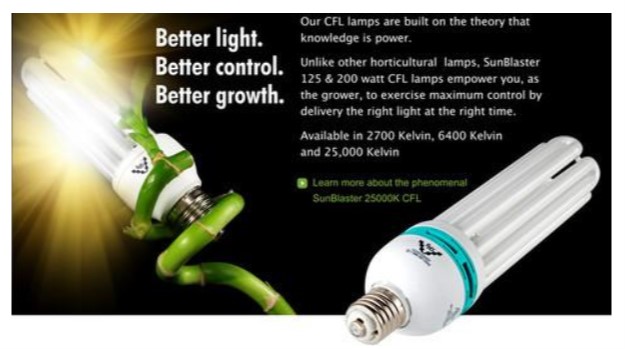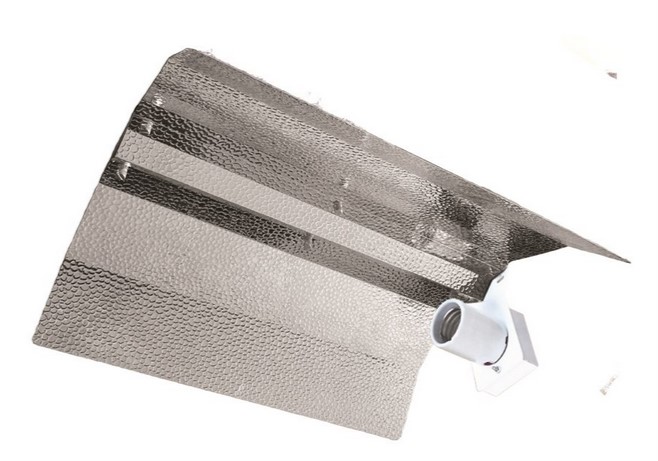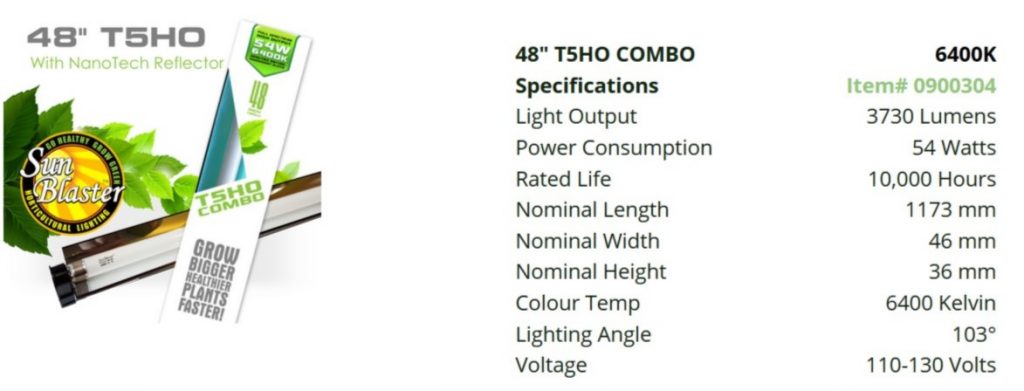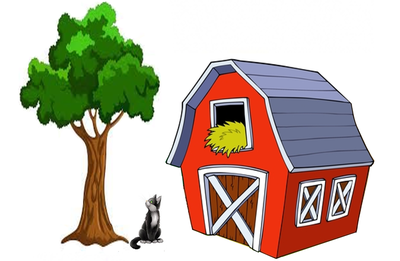We have have had a lot of people ask us about what lights we carry.
The photo at the top of this page is a set of 7-T5HO Bulbs which give incredible grow power.
The evenly dispersed light cannot be beat. Not even by a Metal Halide.
Because we like to try and make things easy, we thought it might be good to just put up a short article about the lights we do carry and why we chose to carry them.
Another thing to consider is the fact that the best lights in the world will not give you a good crop of anything if you are not taking the appropriate measures to grow correctly. Proper use of CO2, your grow medium and nutrients will go a long ways to ensuring a bumper crop of whatever you wish to grow.

CFL (compact fluorescent lighting)
When most people hear CFL they tend to think of the small twisty lights that you screw into a socket.
CFL has come a long way, we have chosen to carry Sunblaster 125 watt and 200 watt CFL bulbs. These Sunblaster bulbs are definitely not the little twisty lights of the past.
They are very advanced and efficient lighting which can really produce tremendous crops if used properly.
CFL bulbs run much cooler then many other lights. That is always a concern when growing in closets, tents or any other room in your house.
We try to keep in stock some smaller bulbs plus the big 6400 K – 125 Watts and 2700 K/6400 K – 200 watt bulbs.

6400 K bulbs are primarily for vegetative growth and 2700 K bulbs are primarily for flowering or budding.
If you have not seen one of these 200 watt bulbs lit up you might want to check it out we have some fantastic reflectors and we can show you one of these bulbs running.

T5HO (strip lights)
T5HO strip lights are the cheaper alternative to LED strip lights. That’s not to say they’re inferior, because they are not.
Depending on what you plan on growing, 350 watts of T5HO Lights can wuite easily yield you 1/2 to 3/4 pound of certain herbs in a single run which is approximately 12-13 weeks from seed to harvest. The same amount of light can also yield you a very large crop of tomatoes or peppers. A couple more lights and a bit more work can yield even more than the numbers above.

LED (light emitting diode)
LED’s come into main flavors, strip lights and the larger box lights.
We have chosen to deal in strip lights for many reasons, strip lights are highly efficient, run very cool, have long lives, are very safe to operate and take very little space. On top of that its much easier to replace a single strip if required.
The other great thing about strip lights, is the ability to easily expand your wattage as plants get bigger. They also make fantastic lights to use vertically in small spaces such as tents or closets.
The main reason we have decided not to run with LED box lights is because of the wide variety that is on the market right now. You can buy these at Walmart and your local hardware store for a bit more than a $100 – $200 bucks. You can also buy some of these led box lights rate on the Amazon Canada site for around $250
Be sure to read the fine print, many of the cheap flights listed on Amazon recommend that they do not stay running for more than 5 to 9 hours at a time. That is not enough time to get through a budding cycle let alone a vegetative cycle during the day.
There are some fantastic LED box lights out there, but the good ones range from $800 up to thousands of dollars. We are not willing to test low quality lights to find the ones that are good for a reasonable price and we don’t want to sell garbage.
The other reason we do not like the cheaper LED box lights is because a lot of them do not even have the correct spectrum of bulbs in them. Most of the good lights have cobb LED”s in them but the cheap ones do not.

HID (MH metal halide & HPS high pressure sodium)
At one time metal halide and high-pressure sodium bulbs were the premium bulb to use if you were going for large crops with good light penetration. The problem with these bulbs is the generate a lot of heat both directly from the bulb and from the ballast which is required to run these bulbs.
These bulbs are not necessarily plug and play items, a lot of the time they require wiring and a little bit of work to get setup.
In my honest opinion it is much easier and safer to stay away from HID lighting. These bulbs can lead to fires, expensive operating costs and complicated cooling scenarios.
In my opinion, this type of lighting is better suited for more of an industrial type operation where power consumption is simply recouped through high product costs.

